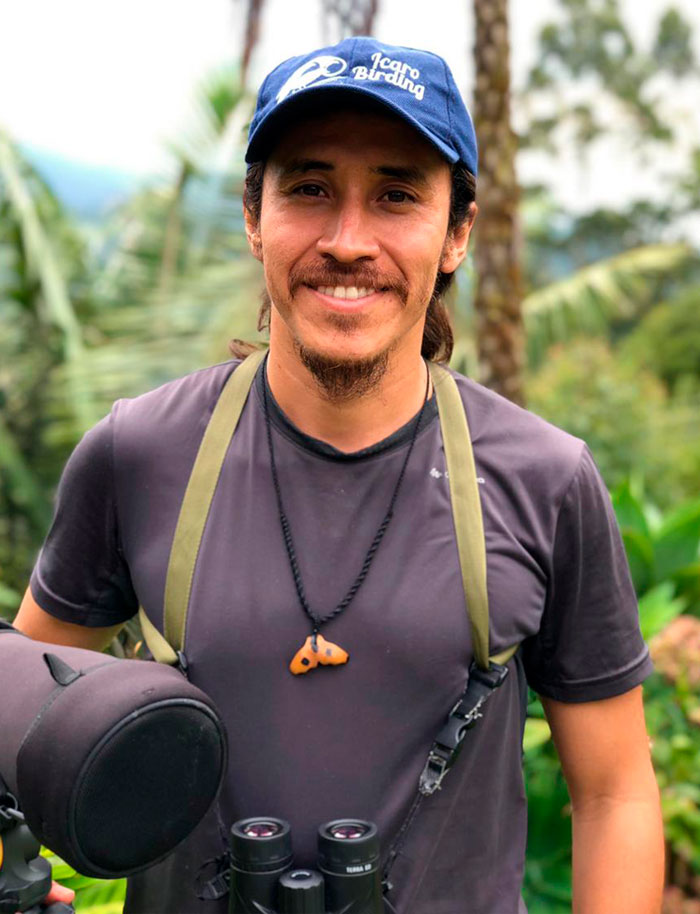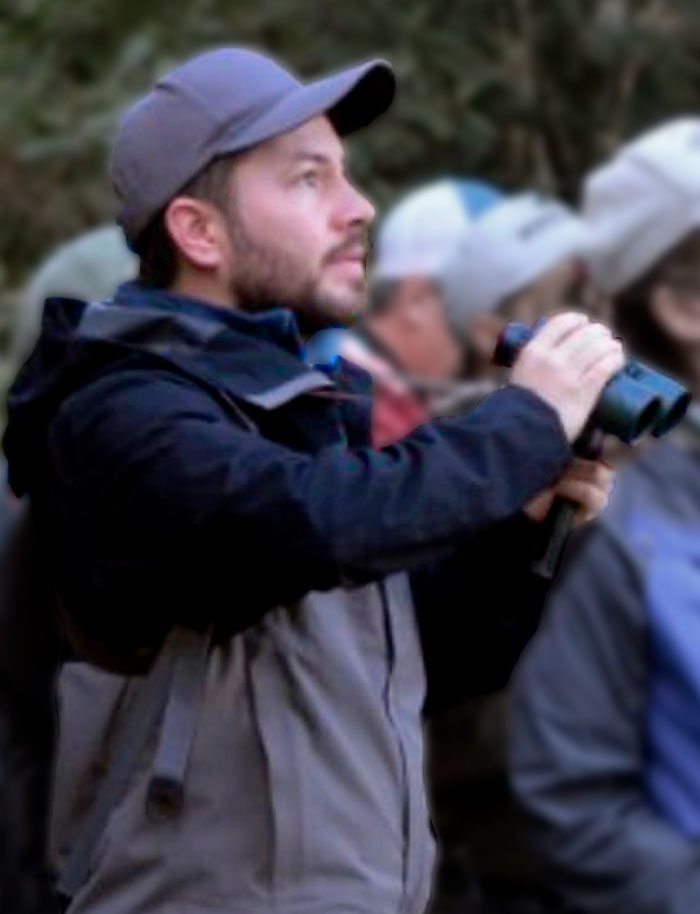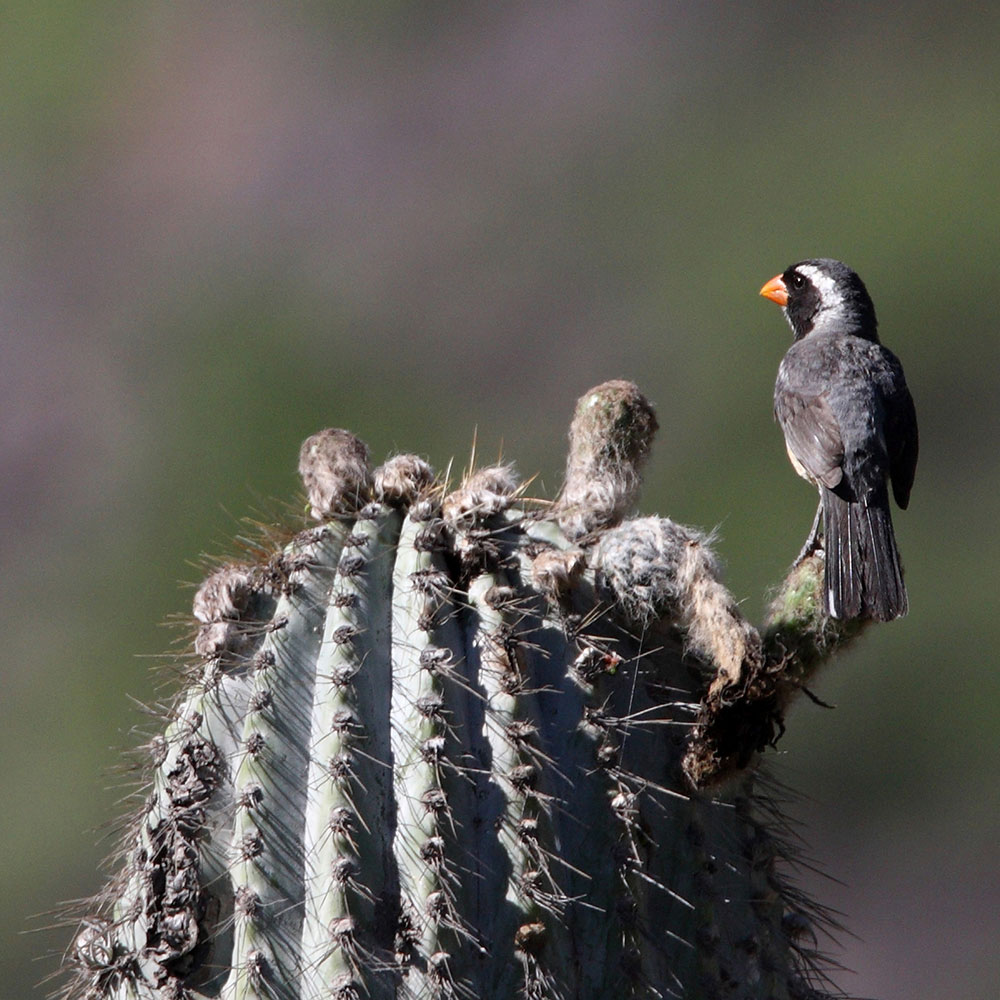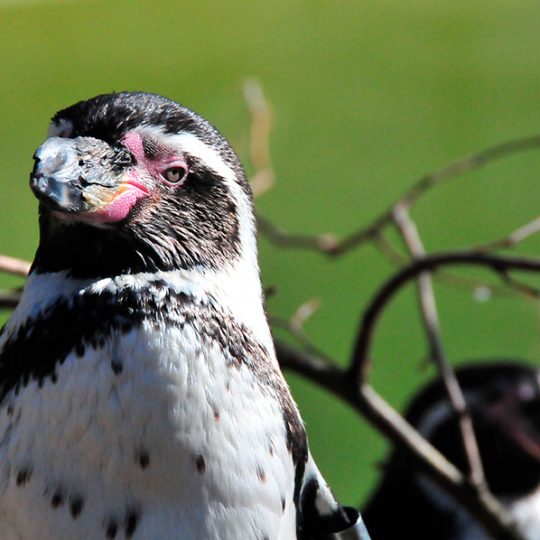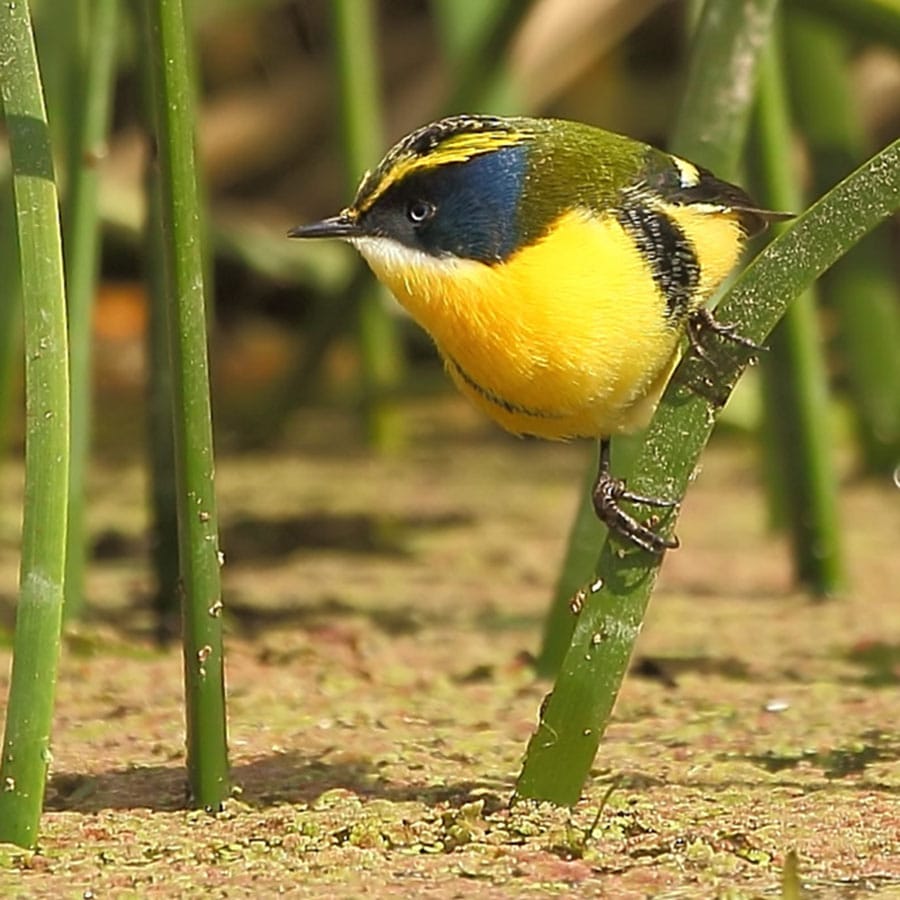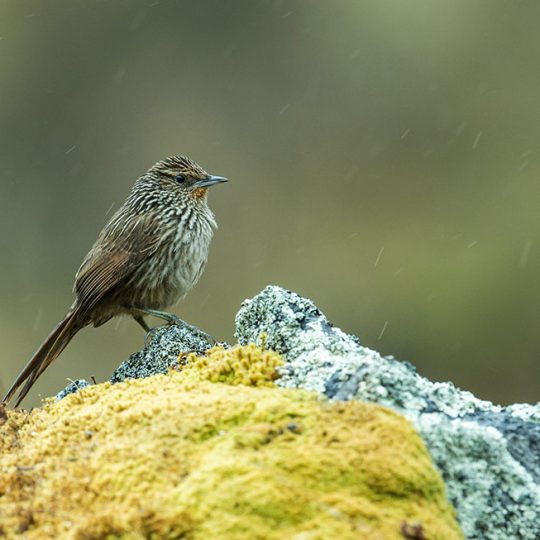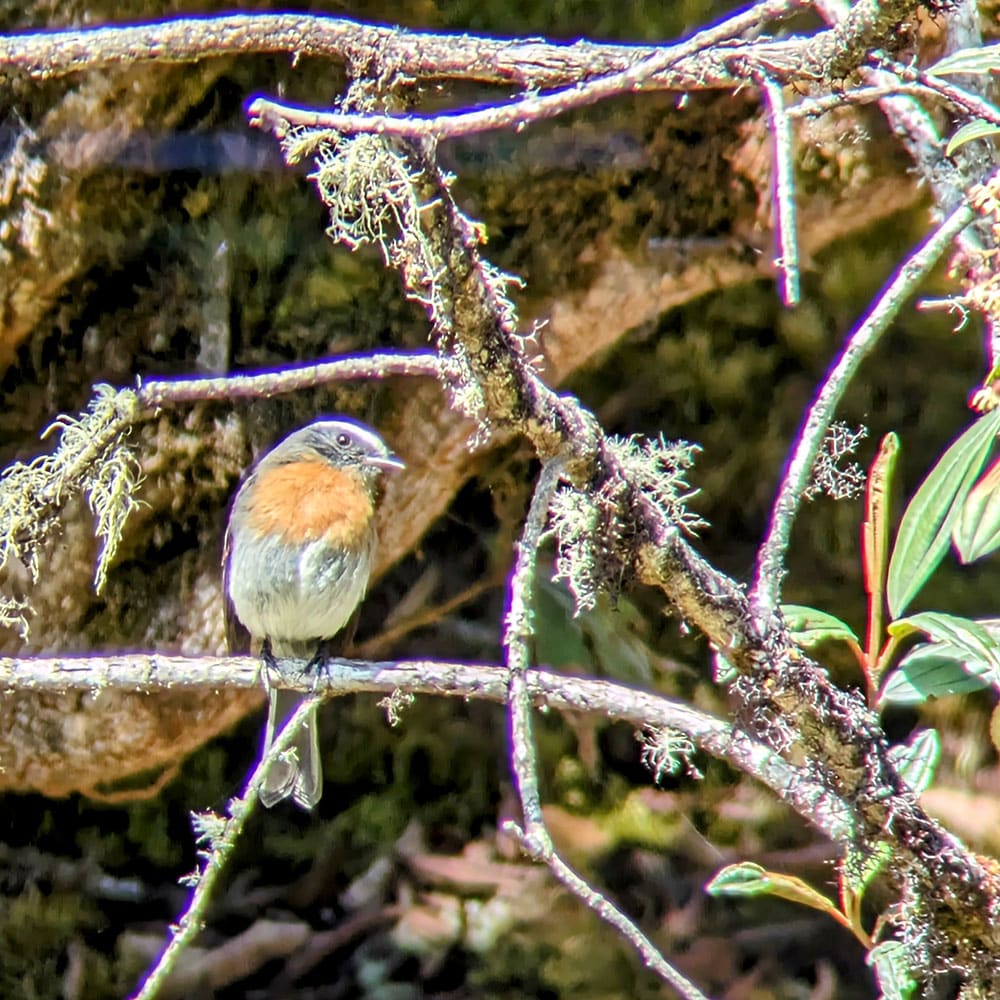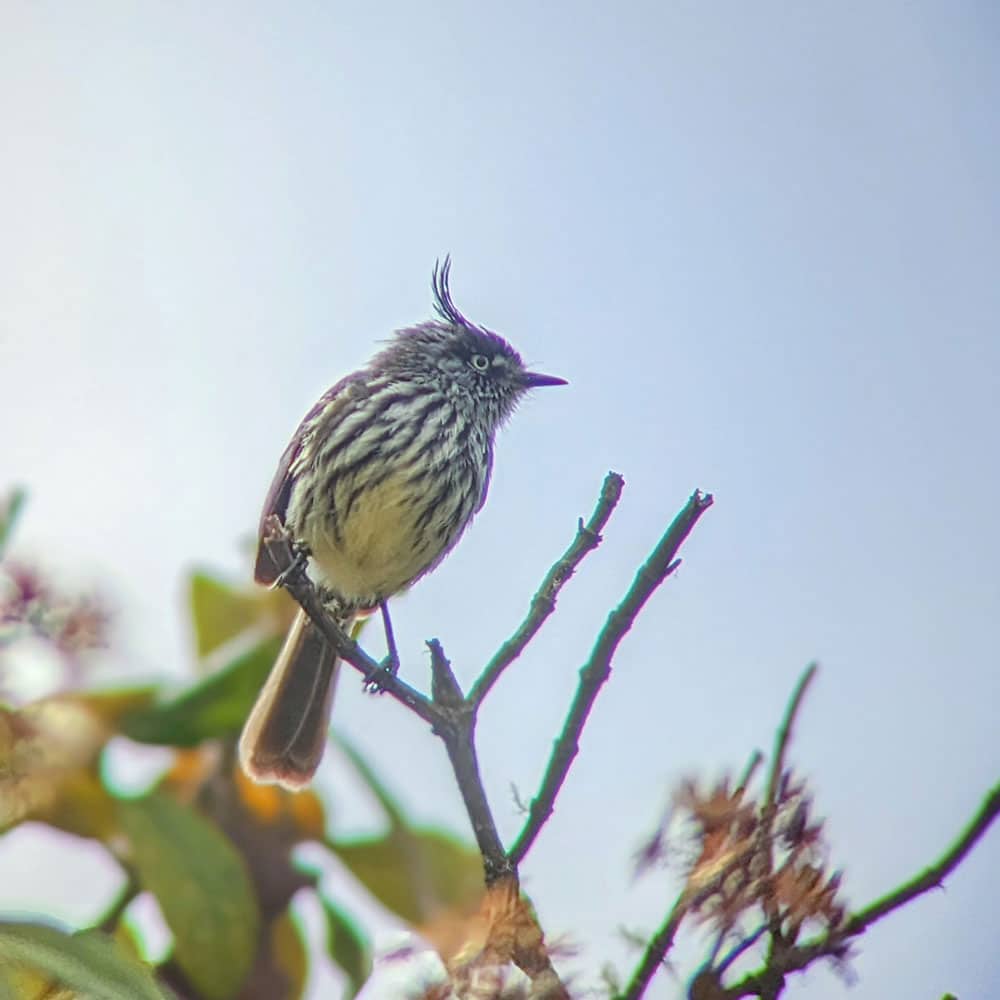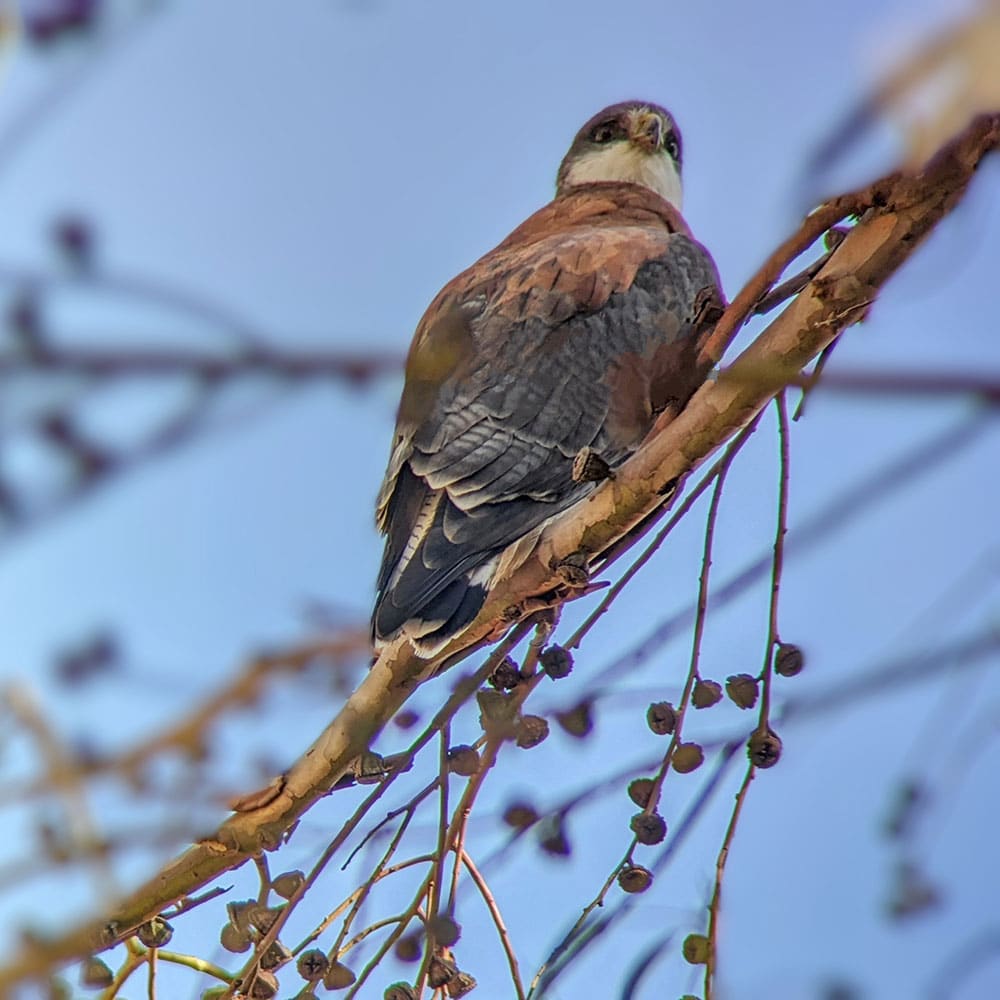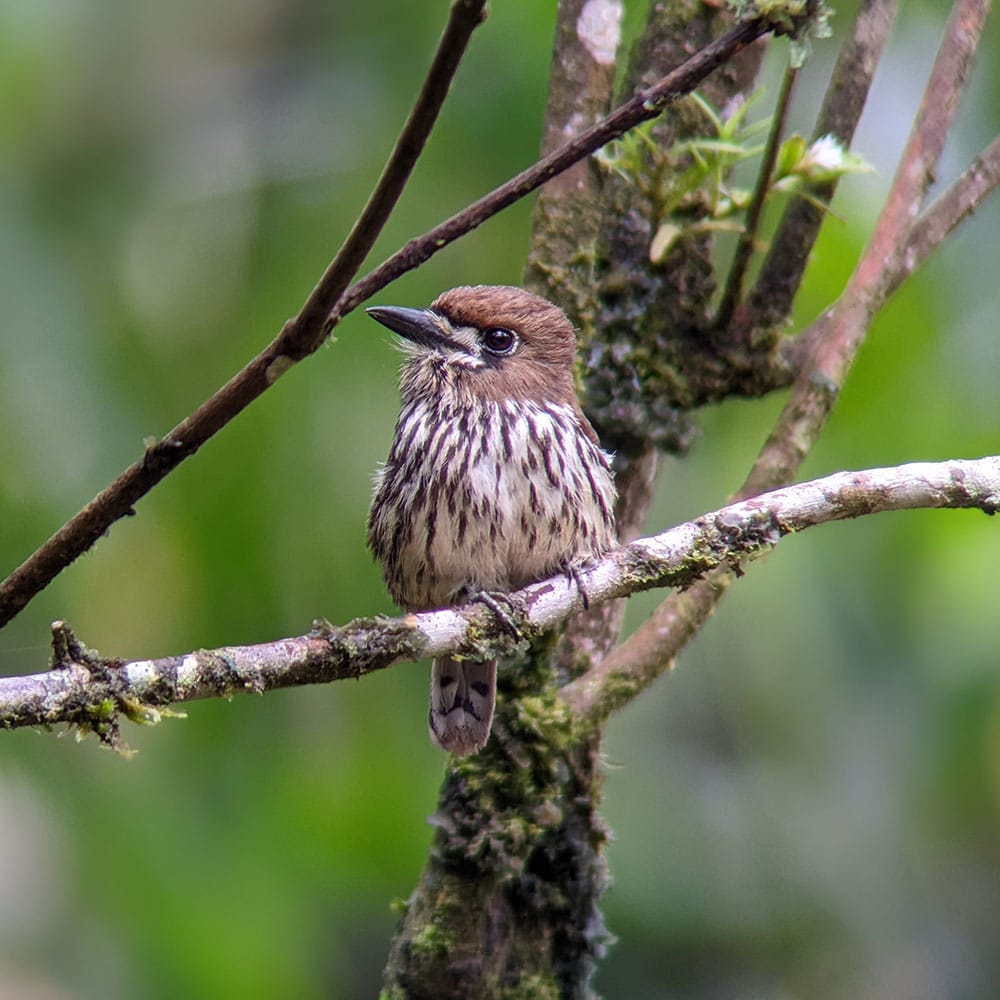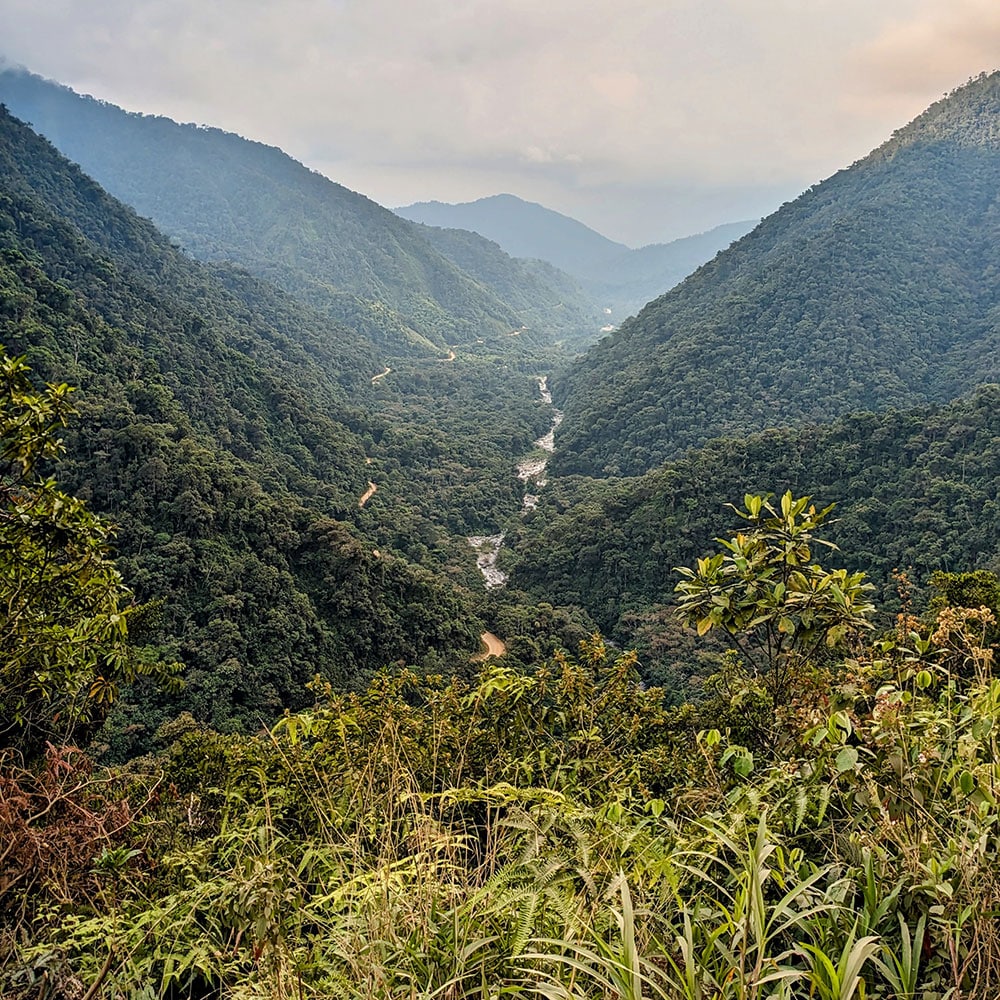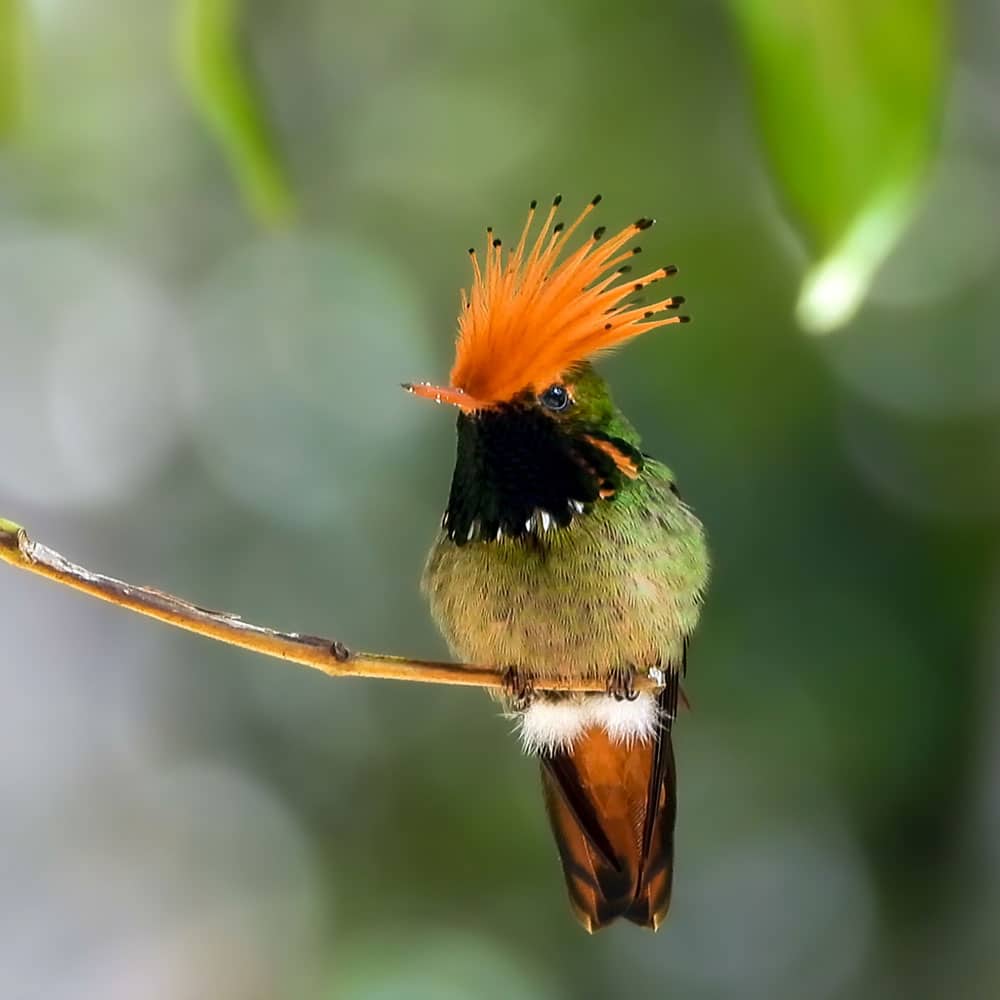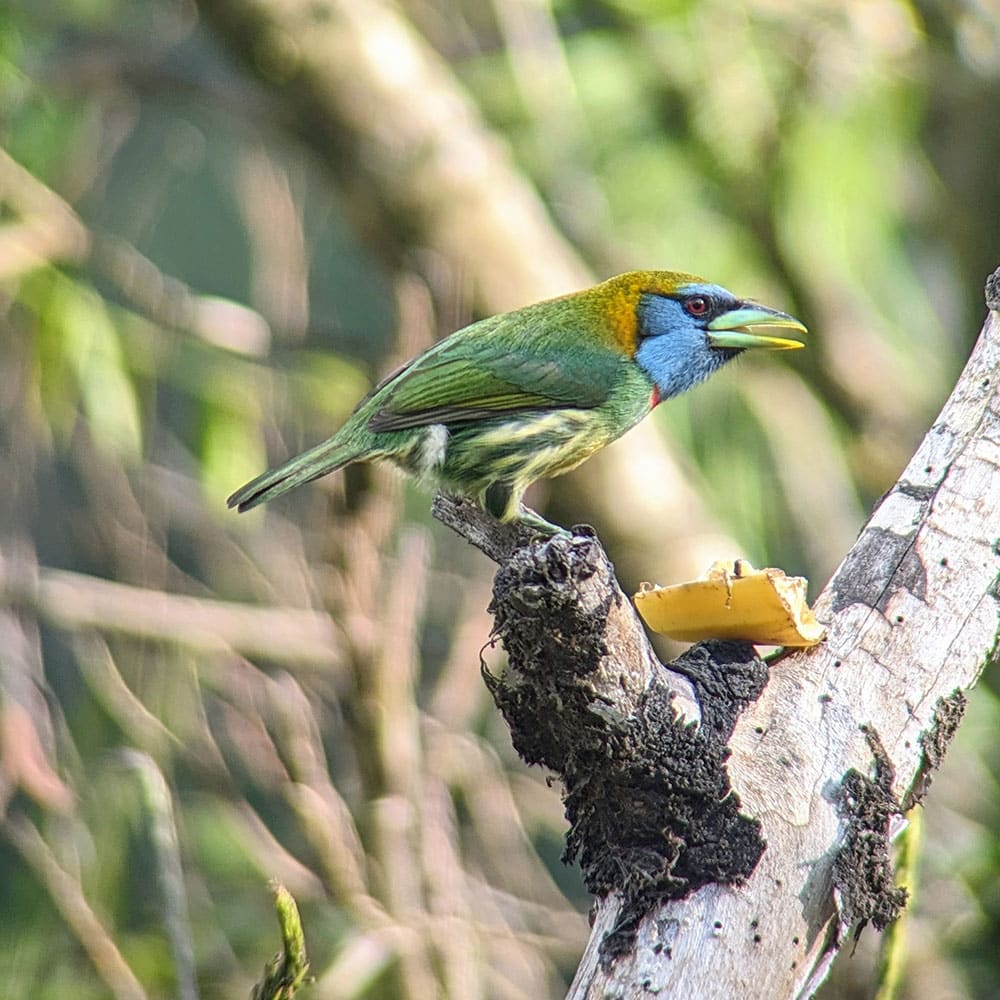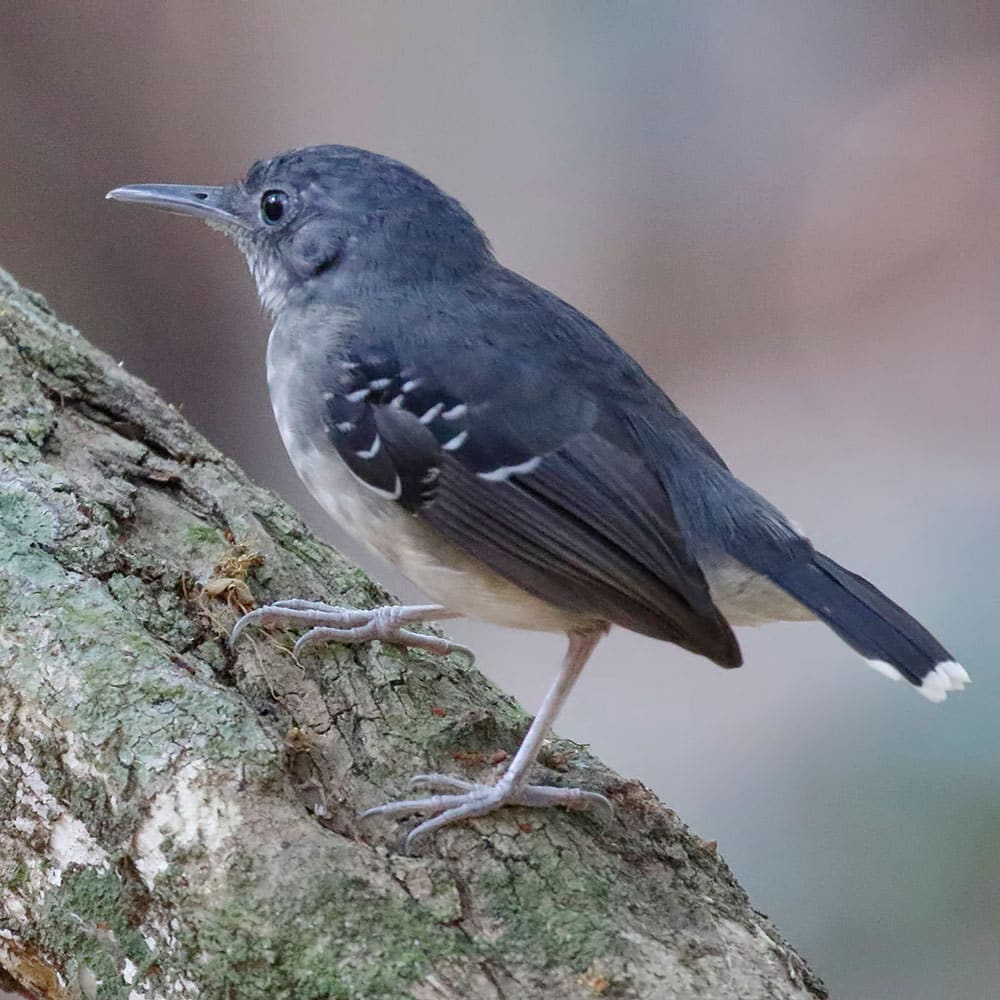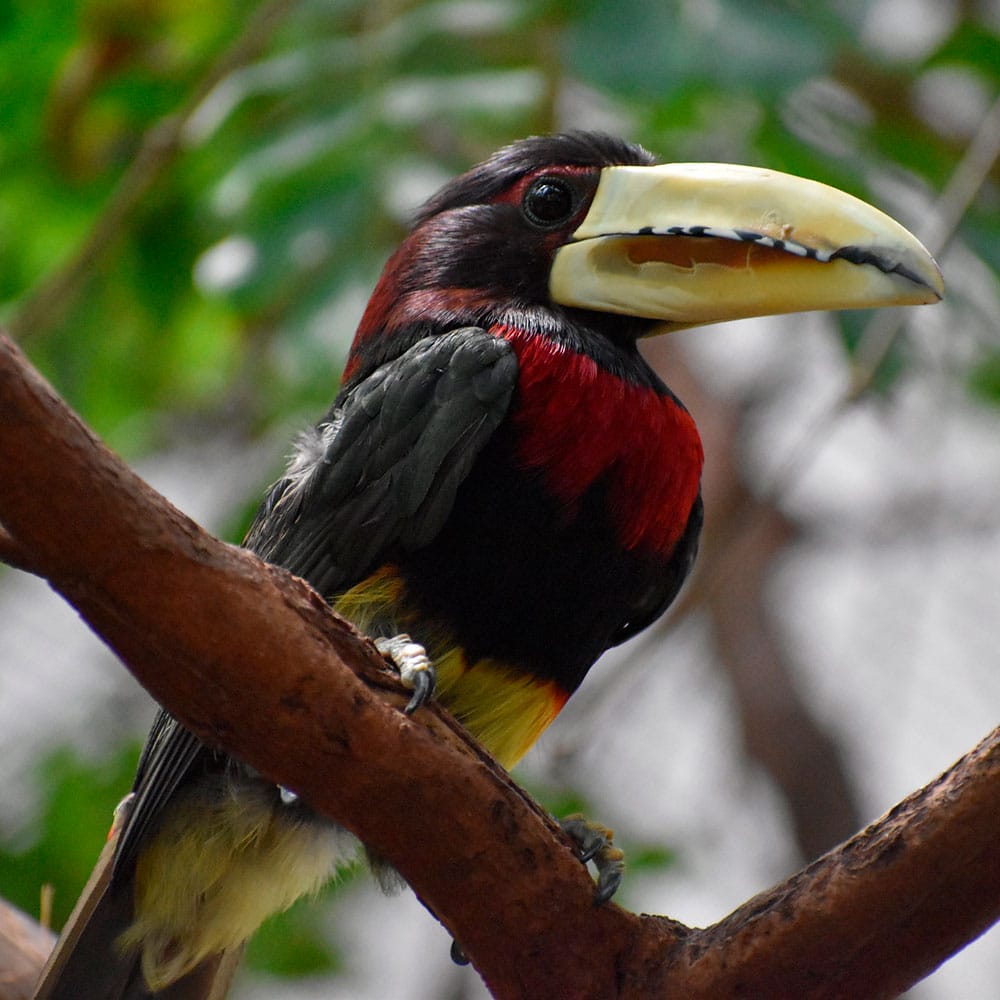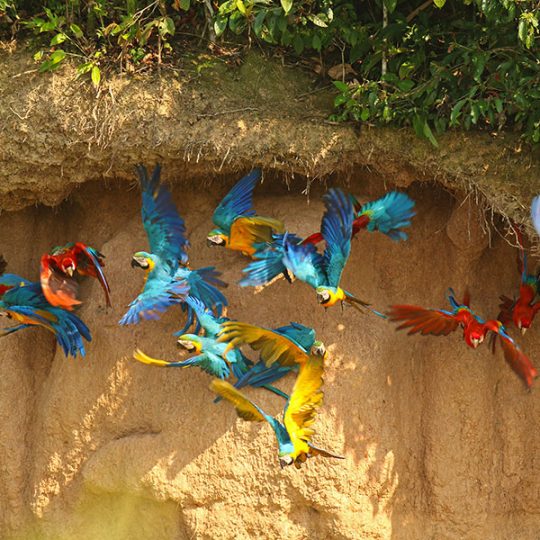
Wild Manu Road Peru Birding tour
Spectacular Peru has much to offer from world-famous ancient civilizations to leading fusion gastronomy and a very large and exciting list of birds: 1,850 bird species including 107 endemics.
Icaro Birding Premier Peru Birding Tour takes place in the Southern region extending from Cusco (the ancient capital of the Inca empire) at 11,300 feet altitude birding the world-famous Manu Road down the Andes to the awesome Manu National Park at 1,000 feet above sea level
Tour Duration: 14 days
Tour Dates: August 14-27, 2024
Tour Price: $6,500 per birder in shared accommodation
Single Occupancy Supplement: $600
Tour Goal: Over 400 bird species including +25 endemics
Tour Size: Limited to 6 participants
Tour Guides: A tour leader from Peru and a guide from Colombia
Birds of particular interest include the globally endangered Humboldt Penguin, endemic Bearded Mountaineer, endemic Masked Fruiteater, endemic Chestnut-breasted Mountain Finch, Golden-billed Saltator, Junin Canastero, Puna Tapaculo, Many-colored Rush Tyrant, Golden-collared Tanager, endemic Red-and-white Antpitta, Cerulean-capped Manakin, Versicolored Barbet, Rufous-crested Coquette, Ivory-billed Aracari, Flammulated Bamboo Tyrant, Ocellated Woodcreeper, Scarlet, Red-and-green, Chestnut-fronted, Blue-and-yellow, and Red-bellied Macaws and many more!
Highlights for the tour
• Semi-pelagic Tour near Lima
• Morning visit to one of the world’s 7-wonders, Machu Picchu!
• Several days birding the famous Manu Road from Cusco at 11,300 feet down to the Amazon rainforest at 1,000 feet asl
• At Manu Road, we can bird the canopy of trees at eye level, which is unusual for the Andes and highly satisfying
• Staying at world-class Wayqecha Biological Station, Cock-of-the-Rock, Villa Carmen Lodge, and Manu Wildlife Center!
• Visit Blanquillo Macaw Clay Lick where hundreds of parrots, parakeets, and parrotlets come to ingest the minerals seeping from the clay cliff face.
• Incredible wildlife including Giant Otter, Monkeys, and Jaguars are possible
• On average you can expect to see some 400 bird species including +25 endemics and many regional specialties
Tour Map
Included in the Tour
• Bilingual birding guide for the entire duration of the tour
• Internal private land transportation
• Internal flights
• All meals starting with lunch on day 1 through lunch on the last day
• Accommodation in the nicest hotels and world-class ecolodges
• Entrance fee to the Fincas, Natural Parks, and Reserves
Not included in the Tour
• International flights
• Comprehensive Medical and personal liability insurance
• Personal expenses (laundry, tips, international phone calls)
• Alcoholic drinks
• Not specified expenses
Day 1 – Transfer Airpot to San Agustin Exclusive Hotel
Our birding tour to Peru starts in Lima, Peru’s capital city. Flights will arrive at Jorge Chávez International Airport. Lima was founded by Spanish conquistador Francisco Pizarro on January 18, 1535, as Ciudad de los Reyes. It became the capital and most important city in the Spanish Viceroyalty of Peru. Following the Peruvian War of Independence (1811-1826), it became the capital of the Republic of Peru.
At the airport you will meet your Birding guide and be transferred from the airport to a comfortable hotel located just a block away, so we walk and do casual birding looking for West Peruvian Dove, Rufous-collared Sparrow, Blue-and-white Swallow, Pacific Parrotlet, Southern Beardless Tyrannulet, Vermillion Flycatcher, Long-tailed Mockingbird.
We will get to know each other over drinks at the hotel, then have dinner and a good night’s rest before the excitement really starts!
Night at San Agustin Exclusive Miraflores Hotel
Meals: L, D
Day 2 – Lima pelagic, Villa Marsh, and Flight from Lima to Cusco
We will have an early breakfast in the hotel and afterward drive for about 45 minutes to Pucusana, a small and picturesque fishing village. There we’ll do our Semi Pelagic Tour. We’ll navigate on our private local boat and search for Peruvian Pelican, Inca Tern, Surfbird, Guanay and Red-legged Cormorant, Elegant Tern, Peruvian Booby, Blackish Oystercatcher, Parrot-billed and Chestnut-throated Seedeater, the endemic Peruvian Seaside (Surf) Cinclodes, the globally endangered Humboldt Penguin as well as several gull species and maybe even a petrel or shearwater or something similarly exciting!
Then we’ll drive for 30 minutes to Villa Marsh Nature Reserve (Pantanos de Villa). It was declared a Ramsar site in 1997. This site is a coastal lagoon with brackish water and abundant emergent vegetation. The wetland is situated in the desert and the main source of water is of underground origin. It is a habitat for waterfowl typical of coastal Peru.
Here we will look for Many-colored Rush Tyrant, Franklin’s, Gray-headed and Belcher’s Gull, Tropical Kingbird, the endemic Coastal Miner, West Peruvian Dove, Greater and Lesser Yellowlegs, Scrub Blackbird, Plumbeous Rail, Peruvian Meadowlark, White-tufted, Pied-billed and Great Grebes, Slate-colored Coot, Striated Heron, Peruvian Thick-knee, Amazilia Hummingbird, Croaking Ground-Dove, Spotted Sandpiper, White-cheeked Pintail, and many more, having lunch in a local restaurant looking for extra species.
Then we’ll drive straight back to Jorge Chávez International Airport in Lima for our short night flight to Alejandro Velasco Astete International Airport in Cusco. Cusco is a city in southeastern Peru, near the Urubamba Valley of the Andes mountain range. It is a fascinating blend of old and new. The site was the historic capital of the Inca Empire from the 13th until the 16th-century Spanish conquest. In 1983 Cusco was declared a World Heritage Site by UNESCO. It sits at 3400 meters (11200 ft) above sea level, with mild day temperatures and cold night temperatures. Days are usually sunny but rains may arrive suddenly.
We’ll arrive in Cusco at around 19:30 hrs and transfer to our comfortable hotel where we will have dinner and a good night’s rest, but before going to bed we recommend you pack a small bag pack with the necessary for your next two days and nights: Birding equipment, hat or cap, mosquito repellent, sun block, long sleeve t-shirt, pants, rain jackets, warm cloth, hiking shoes. The rest of your luggage will be kept safely in the hotel in Cusco for when we return.
Night San Agustin Koricancha
Meals: B, L, D
Day 3 – Cusco to Aguas Calientes
After a very early breakfast we will transfer to Ollantaytambo station for our very scenic train ride for 1.45 hours to Aguas Calientes town (also known as Machupicchu Pueblo) is the closest access point to the historical site of Machu Picchu which is 6 km (3.7 mi) away. There are many hotels and restaurants for tourists, as well as natural hot baths, giving the town its colloquial Spanish name. Aguas Calientes is at 2,000 meters elevation and the temperature is a mild 12 to 24 °C(54 to 75°F) year-round.
On the way we will visit a beautiful garden that is visited by many target species such as Sword-billed Hummingbird, Green-and-white Hummingbird (E), Shining Sunbeam, Great Sapphirewing, Bearded Mountaineer (E), Golden-billed Saltator, Chestnut-breasted Mountain-Finch (E)
After reaching our hotel (which is close to the train station) in town we’ll have lunch and then enjoy some afternoon birding along the Urubamba River and nearby cloud forest for target species. We will try and find Torrent Duck, Andean Gull, White-Capped Dipper, the endemic Green-and-white Hummingbird, Collared Inca, Torrent Tyrannulet, Fasciated Tiger Heron, Mottled-cheeked, Bolivian and Sclater’s Tyrannulet, Spectacled, and Slate-throated Redstart, Rust-and-yellow, Blue-necked, Silvery and Golden-naped Tanager, White-tipped Swift, Cinnamon Flycatcher, the endemic Masked Fruiteater, Variable Antshrike, White-crested Elaenia, Oleaginous Hemispingus, Chestnut- Capped Brushfinch, Blue Dacnis, Mitred Parakeet, Dusky-green Oropendola, American Kestrel and many more…
We will enjoy dinner and overnight in our hotel
Night at Inti Punku Hotel
Meals: B, L, D
Day 4 – Machu Picchu and Ollantaytambo
Today starts with a very early breakfast as we will try to get the first bus up to Machu Picchu. This world-famous tourist attraction is a 15th-century Inca citadel situated on a mountain ridge at 2,430 meters (7,970 ft) elevation, above the Sacred Valley through which the Urubamba River flows.
Machu Picchu was built in the classical Inca style, with polished dry-stone walls. Its three primary structures are the Intihuatana, the Temple of the Sun, and the Room of the Three Windows. Most of the outlying buildings have been reconstructed to give tourists a better idea of how they originally appeared. Machu Picchu was declared a UNESCO World Heritage Site in 1983 and is one of the New Seven Wonders of the World.
We’ll spend some hours in the morning sightseeing and birding around the area around the Inca ruins. We will look for the endemic Inca Wren, White-collared and Andean Swift, Blue-and-white Swallow, House Wren, Rufous-collared Sparrow, Ocellated Piculet, Capped Conebill, White-eared Solitaire, Mountain Caracara, Rust-and-yellow and Saffron-crowned Tanager, White-Bellied Hummingbird, Collared Inca, Azara’s Spinetail, Andean Guan, the endemic Masked Fruiteater, Andean Motmot and even the occasional Andean Condor that may be soaring overhead.
After lunch, we’ll take our train to Ollantaytambo, about 90 minutes away. It is a small town and another important Inca archaeological site located at an altitude of 2,792 m (9,160 ft) above sea level in the province of Urubamba. Nowadays it is a popular tourist destination (as it is one of the starting points for the famous Inca Trail) located in what is called the Sacred Valley of the Incas.
Our laid-back terracotta-style hotel is near the train station and we’ll walk to get there. We should keep an eye out here for the Chiguanco Thrush, Band-tailed Seedeater, Cinereous Conebill, Plumbeous Sierra Finch, Black-backed Grosbeak, and even Aplomado Falcon.
We will then enjoy dinner and a good night’s sleep.
Night at Pakaritampu Hotel
Meals: B, L, D
Day 5 – Peñas, Abra Malaga Pass, Carrizales and back to Cusco
We will have another early breakfast and then a short drive up to our first stop at Peñas with its scrubby vegetation, where some target birds are possible including the endemics Chestnut-breasted Mountain Finch, White-tufted Sunbeam, Rusty-fronted Canastero, and Creamy-crested Spinetail as well as a great variety of hummingbirds.
We will try and find Giant, Black and Green-tailed Trainbearers, Great Sapphirewing, Shining Sunbeam, Sparkling Violetear, and Tyrian Metaltail. We will also look for Golden-billed Saltator, Andean Parakeet, and many more.
We will continue to Abra Malaga Pass at 14,200 feet of elevation and Carrizales with its Polylepis forest. Birding at this altitude requires some extra energy but remember the vehicle is with us at all times. Take some extra water, energy bars, or any other snacks you may like for today’s excursion. The exciting birds we hope to find here are Ash-breasted Tit-Tyrant, Stripe-headed Antpitta, the endemic White-browed Tit-Spinetail, Giant Conebill, Andean Flicker, Cordilleran and Lined-fronted Canastero, Tit-like Dacnis, Andean Lapwing, White-winged, Cream-winged, and Royal Cinclodes, the endemic Junin Canastero, Blue-mantled Thornbill, Thick-billed Siskin and a good chance for Andean Condor.
Once over the pass, the habitat gets more humid, with Chusquea bamboo patches offering us good possibilities for a few endemics: Parodi’s Hemispingus, Unstreaked Tit-Tyrant, and Marcapata Spinetail. We should also find several species of conebills, mountain tanagers and flycatchers, and maybe Puna Tapaculo.
We will then continue our drive to Cusco and if we have time, we will stop on the way to Piuray Lake for some water birds. The lake is in an open scrub area and is surrounded by bulrushes, mud flats, dry scrub, and open fields. The primary attraction is high-elevation water birds such as White-cheeked and Yellow-billed Pintail, Puna and Cinnamon Teal, and White-tufted Grebe. Other species we will search for include Spot-winged Pigeon, Puna Ibis, Andean Goose, and Slate-colored Coot, amongst others.
Dinner and overnight will be back at the hotel in Cusco.
Night at San Agustin Koricancha
Meals: B, L, D
Day 6 – Huacarpay Lake, Manu Road, and Wayqecha Biological Station
Breakfast will be around 5:00 am and we’ll start our birding adventure towards Manu Road. This is a long access road that connects Cusco in the high Andes of Central Peru to the Manu Biosphere Reserve in the Peruvian Amazon. The road goes through several high-elevation passes before descending through various altitudinal zones of largely forested habitats. It is world famous amongst birders!
Our first stop will be at Huacarpay Lake after about half an hour; this natural Andean marsh provides some restricted range habitat species and endemics, and we will look for Puna and Andean Ibis, Andean and Puna Teal, Yellow-billed and White-cheeked Pintail, Andean Duck, Plumbeous Rail, Slate-colored Coot, Andean Lapwing, Puna Plover, Andean Gull, Great and Snowy Egret, Andean Negrito, Cinereous Harrier, Variable Hawk, Eared Dove, Brown-bellied Swallow, and Upland Sandpiper amongst many others. A more scarce species, the White-backed Stilt is sometimes also seen in this area.
We will also look for several other species on the way to the lakes, including the endemic Bearded Mountaineer, Wren-like Rushbird, Many-colored Rush Tyrant, Rufous-naped Ground Tyrant, Chiguanco Thrush, Cinerous Conebill, Peruvian, Mourning and Ash-breasted Sierra Finch, the endemic Chestnut-breasted Mountain Finch, Band-tailed Seedeater and Greenish Yellow Finch.
Then we’ll drive for some 2 hours to Paucartambo village for lunch. Paucartambo is home to the colorful Virgen del Carmen festival (Our Lady of Mount Carmel), held each year on 16 July.
Then we’ll drive up to Acjanaco pass at an elevation of 3,500 meters (11,500 feet) above sea level and from there to the southern tip of the greater Manu National Park. On our way there we hope to get Andean Parakeet, Chestnut-collared Swift, Black-throated, Moustached and Masked Flowerpiercer, Great Thrush, Sedge Wren, Hooded Siskin, Slender-billed Miner, Torrent Tyrannulet, Brown-backed Chat-Tyrant, Plain-colored Seedeater and many more.
We will arrive at Wayqecha Biological Station late in the afternoon. Here we will have dinner and a good night’s rest.
Night at Wayqecha Biological Station
Meals: B, L, D
Day 7 – Wayqecha Biological Station to Cock-of-the-rock Lodge
We will have an early breakfast and do some morning birding. The 1450-acre reserve around Wayqecha is a biodiversity hotspot where treeless plains of the altiplano meet cloud forest. Wayqecha has an average annual precipitation of 1,700 mm, most of which occurs between October and April. The average annual temperature is 12.5°C (55°F), with nighttime lows of 5°C(41°F) and daytime highs that don’t exceed 20°C(68°F).
The field station sits atop a steep slope that drops off sharply into the valley below. Birding is along trails or Manu Road. Our target species here include Sierran Elaenia, the endemic Red-and-white Antpitta, Amethyst-throated Sunangel, Rufous-capped Thornbill, Hooded and Scarlet-bellied Mountain-Tanager, White-collared Jay, Stripe-faced Wood Quail, Scaly-naped Parrot, Barred and Band-tailed Fruiteater, Andean Solitaire, Fulvous Wren, Pearled Treerunner, Rust-and-yellow, Grass-green, Golden-collared and Blue-capped Tanager, Mountain Cacique and many more.
We will continue birding the road with a field lunch until the afternoon when we arrive at our accommodation for the next two nights.
PLEASE TAKE NOTE THERE IS ELECTRICITY FOR 3 HOURS PER DAY ONLY.
Night at Cock-of-the-rock Lodge
Meals: B, L, D
Day 8 – Cock-of-the-rock Lodge
Cock-of-the-rock Lodge is one of the original eco-lodges along Manu Road, adjacent to Manu National Park. The lodge is inside a private conservation area with 12,350 acres (5,000 ha) of cloud forest at 3,609 to 8,858 feet above sea level. The lodge grounds include a sizeable tract of forest with numerous trails, allowing species that may not appear along Manu Road itself. Temperature is usually hot (30°C/86°F) during the day and a bit cooler at night (15°C/59°F).
Breakfast and lunch will be at the lodge today and we will have a full morning and part of the afternoon birding along the road and trails. We will also have some time off to watch hummingbirds at the feeders in front of the kitchen/dining area.
Our target species at the lodge and surroundings include Chestnut-breasted Wren, Scaled Antpitta, Rufous-breasted and Short-tailed Antthrush, Slaty Gnateater, the endemic Cerulean-capped Manakin, Blue Dacnis, Solitary Eagle, Crested and Golden-headed Quetzal, Speckled Chachalaca, Cock-of-the-Rock, Barred, and White-eyed Parakeet, Scaly-naped and Speckle-faced Parrot, Black-streaked Puffbird, Red-eyed Vireo, Blue-banded Toucanet, the endemic Peruvian Piedtail and lots more.
We will also do some night birding here and are looking for Foothill and Rufescent Screech Owl, Rufous-banded Owl, Lyre-tailed Nightjar, and Andean Potoo.
Before or after our night birding we will have dinner and another good night’s rest.
Night at Cock-of-the-rock Lodge
Meals: B, L, D
Day 9 – Cock-of-the-rock Lodge to Villa Carmen Lodge
Cock-of-the-rock Lodge is one of the original eco-lodges along Manu Road, adjacent to Manu National Park. The lodge is inside a private conservation area with 12,350 acres (5,000 ha) of cloud forest at 3,609 to 8,858 feet above sea level. The lodge grounds include a sizeable tract of forest with numerous trails, allowing species that may not appear along Manu Road itself. Temperature is usually hot (30°C/86°F) during the day and a bit cooler at night (15°C/59°F).
Breakfast and lunch will be at the lodge today and we will have a full morning and part of the afternoon birding along the road and trails. We will also have some time off to watch hummingbirds at the feeders in front of the kitchen/dining area.
Our target species at the lodge and surroundings include Chestnut-breasted Wren, Scaled Antpitta, Rufous-breasted and Short-tailed Antthrush, Slaty Gnateater, the endemic Cerulean-capped Manakin, Blue Dacnis, Solitary Eagle, Crested and Golden-headed Quetzal, Speckled Chachalaca, Cock-of-the-Rock, Barred, and White-eyed Parakeet, Scaly-naped and Speckle-faced Parrot, Black-streaked Puffbird, Red-eyed Vireo, Blue-banded Toucanet, the endemic Peruvian Piedtail and lots more.
We will also do some night birding here and are looking for Foothill and Rufescent Screech Owl, Rufous-banded Owl, Lyre-tailed Nightjar, and Andean Potoo.
Before or after our night birding we will have dinner and another good night’s rest.
Night at Cock-of-the-rock Lodge
Meals: B, L, D
Day 10 – Villa Carmen Lodge
We will have an early breakfast and a full day of birding around the trail system and surroundings of Villa Carmen Lodge. We will start early and be back for lunch. After lunch, we will have a break and again go birding in the afternoon.
The Lodge has a bird list of around 650 species and new ones are continually being added to the list. There is a vast amount of birding possibilities around the lodge and some species we will be on the lookout for include all hummingbirds Rufous-crested Coquette, Violet-headed Hummingbird, Gray-breasted Sabrewing, Wire-crested Thorntail, Fork-tailed Woodnymph, Black-eared Fairy, Blue-tailed Emerald, Gould’s Jewelfront, Sapphire- Spangled Emerald, and Golden-tailed Sapphire.
Other birds of interest include Cinnamon-throated and Buff-throated Woodcreeper, Chestnut-capped Puffbird, Bluish-Fronted Jacamar, Pectoral Sparrow, Ringed Antpipit, Rusty-Belted Tapaculo, Crested and Olive Oropendola, Plain-crowned and Dark-breasted Spinetail, Great Potoo, Hoatzin, Military, Blue-headed and Chestnut-fronted Macaw, Pygmy Antwren, Gray Antbird, Blue-headed Parrot, White-eyed Parakeet, Violaceus and Purplish Jay, Great Antshrike, Amazon Kingfisher, Black-capped Tinamou, Blackish Rail, Buckley’s Forest Falcon, Wattled Guan, Pheasant Cuckoo, Koepcke’s Hermit, Rufous-webbed Brilliant, Fine-barred Piculet, Red-billed Scythebill, Dusky-cheeked Foliage-gleaner, Amazonian and Thrush-like Antpitta, Rusty-belted Tapaculo, Mottle-backed Elaenia, Johannes’s Tody-Tyrant, Black-faced Dacnis and many more.
We can again do some night birding before or after dinner and be on the lookout for Mottled Owl, Black-banded Owl, Tawny-bellied Screech Owl, Great, Long-tailed, and Common Potoo.
Afterward, we will enjoy a good night’s rest.
Night at Villa Carmen Lodge
Meals: B, L, D
Day 11 – Villa Carmen Lodge to Manu Wildlife Center
After breakfast, we will head for our next destination, the world-famous Manu!
The Manu Nature Reserve was established in 1968, and Manu National Park was established in 1973. In 1977, UNESCO recognized it as a Biosphere Reserve and in 1987, as a World Heritage Site. The Park covers an area of 1,716,295.22 hectares (17,162.95 km2) which comprises mountainous areas (traversed by creeks and valleys) with elevations close to 4000 m above sea level and a portion of the Amazon Basin plains.
It has the highest biodiversity of any globally protected site and is therefore abundantly rich in fauna and flora, with about 160 species of mammals having been reported in the park, along with more than 1000 bird species, 1300 butterfly species, 155 amphibian species, 132 reptile species, 15000 species of flowering plants and 210 species of fish.
Scanning from the boat on a 6-hour ride downstream we’ll catch Fasciated Tiger-heron, White-banded, White-winged and Southern Rough-winged Swallow, Chestnut-fronted, Scarlet and Red-bellied Macaw, Plumbeous Kite, Dusky-billed Parrotlet, Wood Stork, Tui, Rose-fronted and Cobalt-winged Parakeet, depending of the season, Boreal and Austral migrants are present.
We will arrive at Manu Wildlife Center late in the afternoon. It is a privately owned rainforest reserve, which forms part of the Manu Biosphere Reserve. It is located in the Cultural Reserved Buffer Zone, set aside for indigenous Amazonian peoples. The lodge is on the banks of the Madre de Dios River in pristine rainforest. Rainfall at Manu Wildlife Center is around 2500-3500 millimeters/98-138 inches per year, with most rainfall occurring in the rainy season months from November to April. The average temperature is 28°C (82°F), with daily highs of 34°C (93°F) and nightly lows of 22°C (72°F).
We will have the chance to see more species during our walks around the lodge and these include, Olive Oropendola, Pale-winged Trumpeter, Screaming Piha, Ivory-billed Aracari, Spix’s Guan, Dusky-tailed Flatbill, Tawny-crowned Greenlet, Palm, Opal-crowned and Turquoise Tanager, Casqued Cacique, Razor-billed Curassow, Jabiru, Cocoi Heron, Black Skimmer, Dark-billed Cuckoo, Sclater’s Antwren, Chestnut-winged, and Lineated Foliage-gleaners, Three-striped Flycatcher, Red-billed Pied Tanager, Yellow-shouldered Grosbeak, and Green Kingfisher, to name but a few!
Some of the more interesting and unusual species we will be searching for in the Bamboo include the Rufous-headed Woodpecker, Manu and Striated Antbird, Flammulated Bamboo Tyrant, Large-headed and Dusky-tailed Flatbill, Peruvian Recurvebill, Dusky-cheeked and Brown-rumped Foliage-gleaners, Ihering’s and Ornate Antwren, and more.
Some of the scarcer forest species we will be on the lookout for include Bartlett’s Tinamou, Sunbittern, Pavonine Quetzal, Striolated Puffbird, Fulvous-chinned Nunlet, Cream-colored Woodpecker, Ocellated Woodcreeper, Collared Puffbird, Ruddy Spinetail, Plain Softail, Striped Woodhaunter, Banded and White-throated Antbird, Ash-throated Gnateater, Black- spotted Bare-eye, Black-faced Cotinga, Ochre-bellied Flycatcher, White-bellied Tody-Tyrant, Royal Flycatcher, Musician Wren, Pale-eyed Blackbird, Yellow-shouldered Grosbeak to name but a few.
A visit to the large mammal lick in the forest, apart from attracting Tapirs, Peccaries and maybe a Jaguar, also attracts guans, curassows, chachalacas as well as Rose-fronted and Rock Parakeets, and Dusky-billed Parrotlet.
Dinner and our overnight stay will be in the basic but comfortable Manu Wildlife Center.
Night at Manu Wildlife Center
Meals: B, L, D
Day 12 – Manu Wildlife Center – Blanquillo Macaw Clay Lick – Blanco Oxbow Lake
Early morning, we will visit the popular Blanquillo Macaw Clay Lick, where hundreds of parrots, parakeets, and parrotlets come to ingest the minerals seeping from the clay cliff face.
We may see Scarlet, Red-and-green, Chestnut-fronted, Blue-and-yellow, and Red-bellied Macaw, Blue-headed, Orange-cheeked, Mealy and Yellow-crowned Parrot, Dusky-billed and Amazonian Parrotlet, Cobalt-winged, Tui and Dusky-headed Parakeet and many more!
After this awesome experience, we will have lunch and in the afternoon, we will visit Blanco Oxbow Lake. Here, from a stable floating catamaran platform, we will look for Rufescent Tiger-Heron, Green Ibis, Horned Screamer, Black-billed Seed-finch, Silvered and Band-tailed Antbird, Amazonian Streaked Antwren, Sungrebe, Agami Heron, Hoatzin, Rufous-sided and Gray-breasted Crake, Green-and-rufous and American Pygmy Kingfisher, Pale-eyed Blackbird, and many others.
A family of the endangered Giant otters inhabits the oxbow lakes and small streams, and seeing them will be a big bonus.
We will return to Manu Wildlife Center after an exciting day for dinner and a good night’s sleep, but before settling in for the evening, night birding around our accommodations may produce Long-tailed, Great Potoos, Amazonian Pygmy Owl, Spectacled Owl, Ocellated Poorwill and Silky-tailed Nightjar amongst others.
Night at Manu Wildlife Center
Meals: B, L, D
Day 13 – Manu Wildlife Center to Puerto Maldonado and flight to Lima / Night in Lima or Flight back home
After breakfast we will take our boxed lunch and get onboard our boat for about 3 hours with some birding along the river, looking for Capped Heron, Orinoco Goose, Sand-colored Nighthawk, and perhaps even a Jaguar on the way!
Puerto Maldonado is now a major tourist destination for Peru’s Amazon Rainforest and is home to one of the most thought-out tourism industries in Amazonia. There is a fantastic amount of protected area accessible from Puerto Maldonado, including Tambopata National Reserve, Bahuaja-Sonene National Park, Manu National Park, and many other communal reserves.
During our travels today and in the short time we have in Puerto Maldonado, we will keep our eyes peeled for Black and Greater Yellow-headed Vulture, Double-collared Seedeater, Southern Rough-winged Swallow, Smooth-billed Ani, Upland and Buff-breasted Sandpiper, Blue-black Grassquit, Large-billed Tern, Wood Stork, Saffron Finch, Yellow-rumped Cacique, Limpkin, Black-banded Crake and many more.
We will go to the Padre Aldamiz International Airport and onto a 90-minute cross-Andes flight to Jorge Chávez International Airport in Lima. You will then be transferred to your hotel in Miraflores or stay in the Airport waiting for your international flight.
Night at San Agustin Exclusive
Meals: B, L
Day 14 – Departure from Lima and end of Tour
Depending on your departure time, you will be transferred to Jorge Chávez International Airport for your international flight back home.
Photos Day 3
Golden-billed Saltator
Golden-naped Tanager
Humboldt Penguin
Many-coloured Rush-Tyrant by Pablo Caceres Contreras
Photos Day 5
Junin Canastero by Nick Anthanas
Machu Picchu
Mountain Caracara by Ville Miettinen
Rusty-fronted Canastero by Jon Irvine
Photos Day 8
Field lunch
Rufous-breasted Chat-tyrant
Tufted Tit-tyrant
Variable Hawk
Photos Day 10
Lanceolated Monklet
Manu Road Lanscape
Rufous-crested Coquette by Banu R
Versicolored Barbet
Photos Day 12
Band-tailed Antbird by Dave Curtis
Ivory-billed Aracari by Laura Wolf
Macaw Clay Lick
Striated Antbird by Jon Irvine


